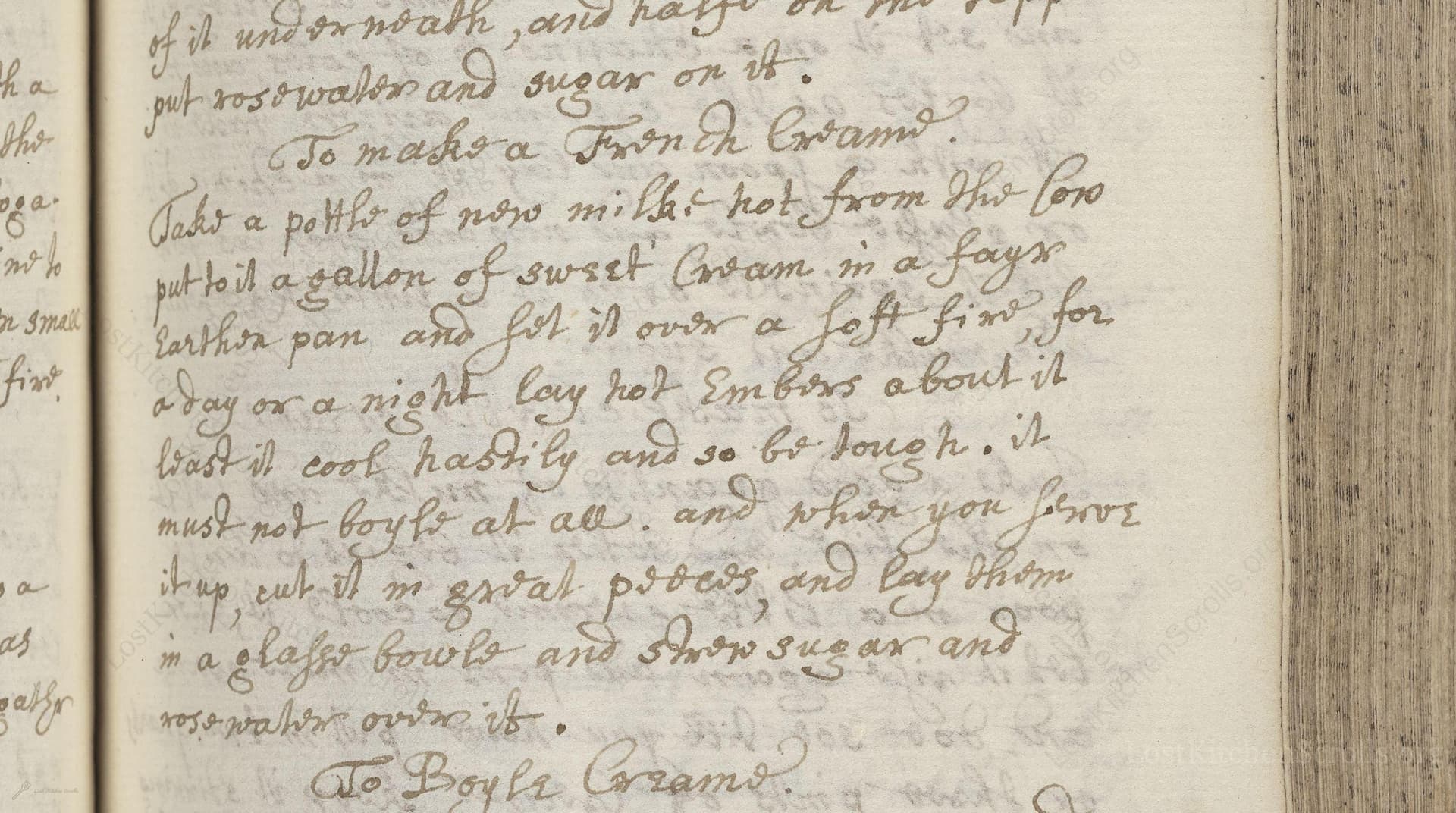To Make A French Creame
From the treasured pages of Manuscript cookery book
Unknown Author

To Make A French Creame
"Take a pottle of new milke hot from the Cow put to it a gallon of sweet Cream in a fayre earthen pan and set it over a soft fire, for a day or a night lay hot Embers about it least it cool hastily and so be sower, it must not boyle at all. and when you have it up cut it in great peeces and lay them in a glasse bowle and strew sugar and rosewater over it."
Note on the Original Text
The recipe is written in typical late 17th-century English, with phonetic spellings (such as 'boyle' for 'boil' and 'sower' for 'sour') and a lack of standard punctuation or precise measurements. Directions focus more on process—describing careful temperature management and the importance of slow thickening—than on exact timings or culinary yields. This hands-on, intuitive style presumes familiarity with local dairy, fire management, and the practicalities of a well-run kitchen. The spellings and grammar are charmingly unstandardized, reflecting the personal, domestic nature of manuscript recipe collections of the era.

Title
Manuscript cookery book (1680)
You can also click the book image above to peruse the original tome
Writer
Unknown
Era
1680
Publisher
Unknown
Background
A tantalizing window into the kitchens of yesteryear, this late-17th century collection presents recipes and culinary wisdom meant to delight and surprise even the most discerning of historical gourmands.
Kindly made available by
Folger Shakespeare Library
This recipe, dating from approximately 1675 to 1686, hails from a period when England was enthusiastically embracing French culinary influences. The treat known as 'French Creame' typifies the Anglo-French exchange: a luxurious, softly-set cream dessert scented with exotic rosewater and liberally sweetened, offered at banquets and special occasions. It reflects the era’s infatuation with dairy’s richness and the newly accessible decadence of sugar and aromatics imported through flourishing trade networks. In an age before refrigeration, such recipes were both delicacies and showcases of dairy husbandry, made with the freshest milk and cream, often just hours old and straight from the estate’s cows.

The original cook would have used a 'fayre earthen pan'—a large, glazed earthenware bowl or broad pan—set near a gentle hearth or in the residual warmth of an oven, surrounded overnight with glowing wood embers to keep the mixture gently warm without scorching. Simple kitchen knives or spoons would cut the thickened cream, and serving would be in a glass or fine ceramic bowl. Rosewater and sugar were added just before serving, most likely with a spoon or a sprinkle directly from the jar.
Prep Time
5 mins
Cook Time
18 hrs
Servings
12
We've done our best to adapt this historical recipe for modern kitchens, but some details may still need refinement. We warmly welcome feedback from fellow cooks and culinary historians — your insights support the entire community!
Ingredients
- 2 quarts plus 1 cup fresh whole milk (ideally non-homogenized; substitute with best-quality whole milk)
- 4 quarts plus 3 cups double cream (or heavy cream)
- Caster sugar, to taste
- Rosewater, to taste
Instructions
- Begin by gently warming 2 quarts plus 1 cup of fresh whole milk (ideally non-homogenized for best results) directly from the refrigerator, bringing it just up to cow's body temperature—around 99°F.
- Stir in 4 quarts plus 3 cups of fresh double (heavy) cream in a large, preferably ceramic or glass, bowl.
- Place the bowl in a very low oven (about 105°F), or keep it in a warm spot such as on top of a radiator or near a warming element, to mimic the effect of surrounding the bowl with warm embers—a gentle, continuous warmth—for 12-24 hours.
- Do not allow the mixture to boil or even simmer; the goal is a very slow, gentle thickening.
- Once set with a delicate, custardy curd, cut the cream into spoonful-sized pieces, transfer these to a serving dish, and lavishly sprinkle with caster sugar and a drizzle of rosewater before serving.
Estimated Calories
700 per serving
Cooking Estimates
It takes about 5 minutes to prepare the ingredients and set up the milk and cream, but the mixture needs to warm gently for around 18 hours to develop its unique texture. Each serving is rich and indulgent.
As noted above, we have made our best effort to translate and adapt this historical recipe for modern kitchens, taking into account ingredients nowadays, cooking techniques, measurements, and so on. However, historical recipes often contain assumptions that require interpretation.
We'd love for anyone to help improve these adaptations. Community contributions are highly welcome. If you have suggestions, corrections, or cooking tips based on your experience with this recipe, please share them below.
Join the Discussion
Rate This Recipe
Dietary Preference
Main Ingredients
Culinary Technique

Den Bockfisch In Einer Fleisch Suppen Zu Kochen
This recipe hails from a German manuscript cookbook compiled in 1696, a time whe...

Die Grieß Nudlen Zumachen
This recipe comes from a rather mysterious manuscript cookbook, penned anonymous...

Ein Boudain
This recipe comes from an anonymous German-language manuscript cookbook from 169...

Ein Gesaltzen Citroni
This recipe, dating from 1696, comes from an extensive anonymous German cookbook...
Browse our complete collection of time-honored recipes



